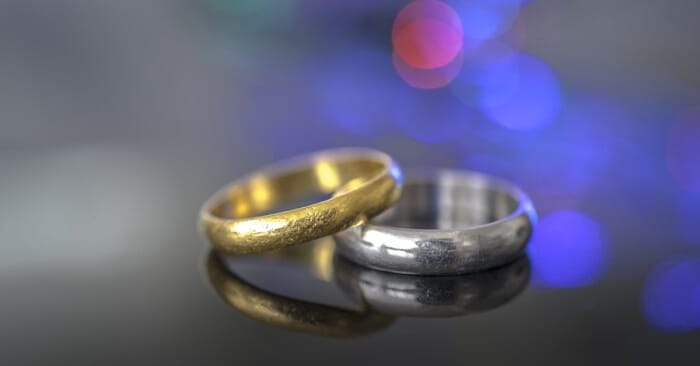Gold and platinum are the two precious metals most commonly used for crafting fine jewelry. Both are admired for their appearance, value, and durability. But there are many differences between them, some apparent and others more obscure or even surprising.
If you’re looking to buy jewelry but can’t decide between gold jewelry versus platinum jewelry, you are at the right place!
As you’ll discover, both gold and platinum are ideally suited for jewelry. In principle, one is not better than the other. And what may be the right choice for your friend might not be the right one for you.
Read on to learn how gold jewelry compares to platinum jewelry and which of the two best cover your needs.

Gold vs. Platinum Jewelry
Besides the fact that gold and platinum are precious metals, ideally suited for jewelry, they are both measured by the troy ounce. A troy ounce is equivalent to 31.1034 grams – not to be confused with a “regular” ounce that weighs only 28.3495 grams.
The main differences between gold and platinum include the following:
Color
Gold
Pure gold always has a natural yellow color.
By mixing gold with other alloys (metals), we can create different colors, such as:
- Rose Gold – A gold-copper alloy that typically contains 75% gold and 22.25% – 25.00% copper, and sometimes a small amount of silver, to make 18k rose gold.
- White Gold: An alloy typically containing 75% pure gold and 25% white metals such as nickel, silver, zinc, or palladium. Most white gold jewelry is rhodium-plated.
Platinum
A naturally white metal – it gets its name from the Spanish term Platino or “little silver.”

Purity
Gold
The purity of gold is measured in karats, with pure gold being 24 karats. Since gold is very soft and malleable, jewelry never contains 100% gold.
In the United States, most jewelry has a purity of 14 karats and sometimes 18 karats.
14 karats = 58.3% pure gold.
18 karats = 75.0% pure gold.
The balance is typically a mixture of other metals like copper, zinc, silver, and nickel. These metals add strength to the jewelry making it less likely to break.
Platinum
Platinum jewelry typically contains between 95% and 98% pure platinum. The balance is made up of metals like palladium, ruthenium, iridium, rhodium, copper, or cobalt.
Appearance
The only visual difference between gold and platinum jewelry is color, except for white gold.
Gold is naturally yellow, while platinum is naturally white. However, white gold jewelry (originally developed to imitate platinum) is often hard to distinguish from platinum jewelry. So if you want white jewelry, you have a choice between platinum and white gold.
When platinum is polished, it becomes more reflective and appears bright white. White gold often has a slightly off-white color, even when polished. But if it’s rhodium-plated (which it usually is), it can take on an even brighter white appearance than platinum.
In principle, platinum will retain its appearance for longer because of its purity, while white gold might have to be replated every couple of years.
Note: White gold often contains nickel, which might cause some people to experience an allergic reaction when wearing it.

Wear and Tear
Platinum and gold are both durable, but platinum is a dense, highly unreactive metal, making it more durable than gold. So it takes longer for platinum to wear away than gold.
However, despite being more durable, platinum is actually softer than 14k gold and will scratch easier. But, when gold is scratched, the gold is lost. When platinum is scratched, the platinum only migrates from one place to another but isn’t lost.
In addition, when polishing platinum, it makes it smoother and not thinner, which means you can polish your platinum jewelry as often as you like.
For the above reasons, unlike platinum, gold jewelry often loses a small amount of weight over time. The most durable gold jewelry is rose gold due to its high copper content.
As far as maintenance is concerned, in order from the lowest to the highest maintenance, platinum requires the lowest amount of maintenance. Platinum is followed, in order, by rose gold, yellow gold, and white gold.
How to Decide
Platinum jewelry is more durable than gold jewelry and typically requires less maintenance. If you want your jewelry to have a white color and can afford it, platinum is your best option. However, gold jewelry is also durable, comes in several colors, and is typically more affordable.
One last but important factor to consider is your skin tone.
Skin Tone
Skin tone is an important factor in how good jewelry looks on you.
There are three main skin tones – warm, cool, and neutral.
Warm skin tone
If you have greenish veins on your wrist, tan easily, and seldom get sunburn (or your skin is black or brown), you typically have a warm skin tone.
– Your best match is yellow gold or rose gold.
Cool skin tone
If you have blue (or sometimes purple) veins on your wrist, don’t tan easily, have pale skin, and are prone to sunburn, you typically have a cool skin tone.
– Your best match is platinum or white gold.
Neutral skin tone
If your skin tone is neither a match for a warm skin tone nor a cool skin tone, you likely fall somewhere in between and have a neutral skin tone.
– You have the best of both worlds. Both gold and platinum jewelry will look good on you.
Note: Always look at the veins on your wrist under natural light.
That's a Wrap
If you’re looking to buy jewelry but could not decide between gold jewelry versus platinum jewelry, we trust you’re now in a better position to make a decision.
Our advice is you should always wear jewelry that you love.
As explained in our article about why you should buy jewelry at a pawn shop, pawn shops are a great place to shop for jewelry and get expert advice on what items are a good fit for you.
And if you have any jewelry that you would like to sell, pawn, or have evaluated, Maxferd has in-house experts who are ready to assist you.
Call us at (800) 888-7296 or visit one of our pawn shops in Los Angeles or our San Francisco pawnshop to find out how we can assist you.

